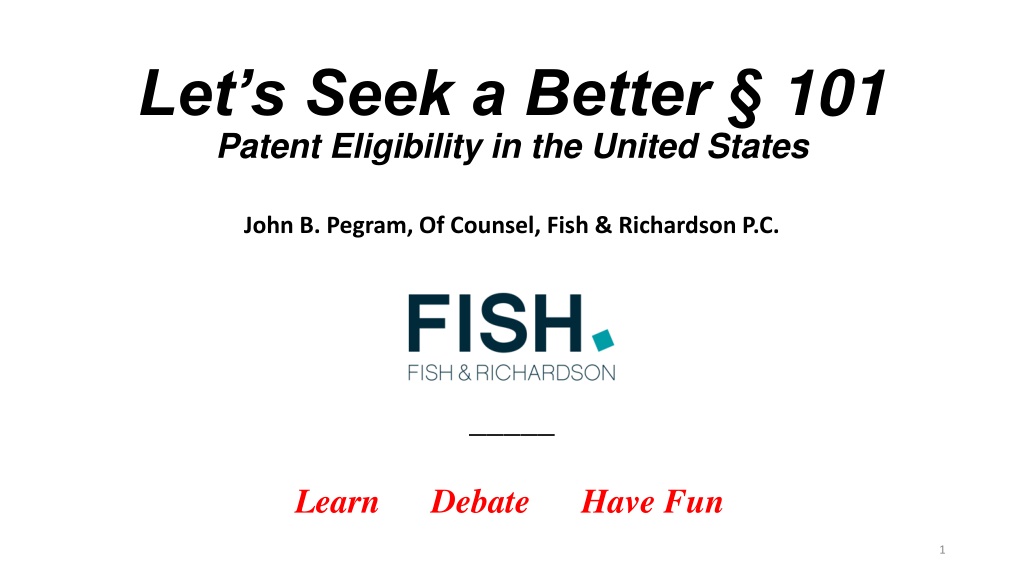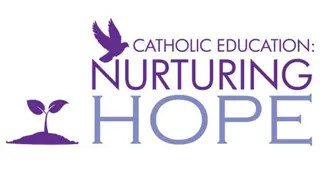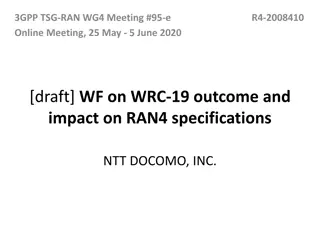Seeking Improved Patent Eligibility in the US
The patent eligibility jurisprudence in the United States is described as a mess, impacting crucial future technologies. This article delves into the history of patent laws, Congressional intent, and the challenges faced since 1952, urging a reevaluation and improvement in the patent eligibility criteria.
Download Presentation

Please find below an Image/Link to download the presentation.
The content on the website is provided AS IS for your information and personal use only. It may not be sold, licensed, or shared on other websites without obtaining consent from the author. Download presentation by click this link. If you encounter any issues during the download, it is possible that the publisher has removed the file from their server.
E N D
Presentation Transcript
Lets Seek a Better 101 Patent Eligibility in the United States John B. Pegram, Of Counsel, Fish & Richardson P.C. _____ Learn Debate Have Fun 1
Its a Mess Our patent eligibility jurisprudence is in shambles." Senator Thom Tillis 2
The most important technologies of the future are being impacted, including diagnostics, bioinformatics, artificial intelligence, digital processing, and many more. Former USPTO Director Andrei Iancu 3
U.S. Constitution Article I, Section 8, Clause 8 The Congress shall have power To promote the progress of useful arts, by securing for limited times to inventors the exclusive right to their discoveries. NOTE: Congress, not the Courts Discoveries very broad 4
1952 Patent Act Title 35, United States Code A post-World War II, complete revision of US patent law Congress relied on the patent bar and Patent Office National Coordinating Committee of patent attorneys Giles Rich President, NYPLA P.J. Federico Patent Office Result: A broad and neutral patent law A detailed legislative history 5
35 U.S.C. 101 Whoever invents or discovers any new and useful process, machine, manufacture, or composition of matter, or any new and useful improvement thereof, may obtain a patent therefor, subject to the conditions and requirements of this title. ( this title means the Patent Act) The requirement of novelty and the new requirement of nonobviousness were placed in Sections 102 and 103, respectively. 6
The Congressional Intent The Supreme Court said in Diamond v. Chakrabarty, in 1980: The Committee Reports accompanying the 1952 Act inform us that Congress intended statutory subject matter to include anything under the sun that is made by man. " 447 U.S. 303, 309 (1980) (citing S. Rep. No. 1979, 82d Cong., 2d Sess., 5 (1952); H. R. Rep. No. 1923, 82d Cong., 447 U.S. 303, 2d Sess., 6 (1952)). . 7
Today: Its a Mess Since 1952, the Supreme Court has narrowed patent eligibility We are all responsible Judges Attorneys Businesses Academics Public Interest groups 8
Patent Eligibilitya Threshold Question? Patent eligibility was described as a threshold question at least as early as Diamond v. Diehr in 1981 This has led the USPTO to examine patent eligibility first When he was USPTO Director, David Kappos suggested that examining first under other sections of the Patent Act might be better. Many court cases have addressed patent eligibility on an early motion to dismiss Some in the Tech Industry appear to like this, for patents of others Inconsistent with general preference of judges for avoiding motions to dismiss Some judges have suggested that patent eligibility involves questions of fact, precluding early dismissal by motion Patent owners have flocked to courts holding to that view 9
The Cure Must Come from Congress Remember the Constitution: The Congressshall have power To promote the progress of useful arts, by securing for limited times to inventors the exclusive right to their discoveries. The Supreme Court agrees: It is, of course, correct that Congress, not the courts, must define the limits of patentability . Chakrabarty, 447 U.S. at 315. 10
Legislative Efforts Stalled Most members of Congress like patent legislation Usually, it is something both parties can agree on They typically seek a consensus from affected groups before acting Legislative efforts for a patent eligibility cure stalled in Summer 2019, because there was no consensus Different interest groups wanted to include different limitations 11
My Proposal We should return to the 1952 Patent Act s intent, to include anything under the sun that is made by man, and Not be tempted to deviate from that. 12
A Good Start Draft Proposal by Senators Coons & Tillis, May 22, 2019: Section 100 Definitions: (k) The term useful means any invention or discovery that provides specific and practical utility in any field of technology through human intervention. Section 101 Inventions Patentable: (a) Whoever invents or discovers any new and useful process, machine, manufacture, or composition of matter, or any new and useful improvement thereof, may obtain a patent therefor, subject to the conditions and requirements of this title. (b) Eligibility under this section shall be determined only while considering the claimed invention as a whole, without discounting or disregarding any claim limitation. 13
Lead Us Not Into Temptation Let s try to: Avoid the temptations to address perceived problems by limiting patent eligibility, We should limit patent law to patent issues We should address other issues in other ways. Avoid the temptations to tack on limitations, both in and out of Congress Compromises may restrict eligibility and create more litigation. The Devil may tell us, compromise is the way it is done, But I ask is that the right way for an effective patent system? 14
The End Disclaimer The purpose of this presentation is to provide educational and informational content, and is not intended to provide legal services or advice. The opinions, views and other statements expressed by the presenter are solely those of the presenter, and do not necessarily represent those of his employer, clients or the organizers of any meeting at which they are presented. Learn Debate Have Fun 15























